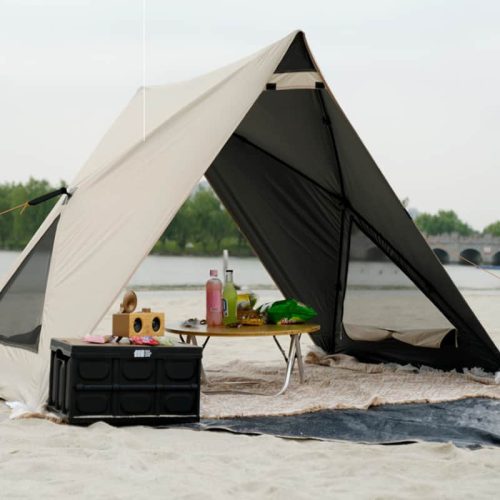A beach tent is a portable shelter for the beach that provides shade and protection from the sun, wind, and sand. It’s lightweight, easy to set up, and made of breathable material. Look for UV protection, good ventilation, stability in windy conditions, and consider the size and portability. Enjoy your time at the beach while staying protected!
Table of Contents

1. Functions and uses of beach tents
Beach tents are versatile and practical structures that offer various functions and uses when spending time at the beach. Here are some of the key functions and uses of beach tents:
- Sun Protection: One of the primary purposes of beach tents is to provide shade and protection from the sun. They offer a sheltered area where you can escape the direct sunlight, reducing the risk of sunburn and overheating. Beach tents typically have built-in sun protection features like UV-resistant materials or coatings to enhance sun protection.
- Wind Protection: Beach tents are designed to withstand coastal winds, providing a barrier against strong gusts that can kick up sand and create discomfort. They offer a more sheltered and stable environment compared to open beach spaces, allowing you to relax without being constantly exposed to wind.
- Privacy: Beach tents provide a sense of privacy in crowded beach areas. They create a defined space where you can change clothes, take a nap, or have a quiet moment away from the hustle and bustle of the beach. This privacy feature can be particularly useful for families with young children or individuals who prefer some seclusion.
- Storage and Organization: Beach tents often have pockets, hooks, or storage compartments where you can keep your belongings organized and within reach. They provide a designated space for storing items such as towels, sunscreen, snacks, books, and beach toys. This helps keep your personal items secure and prevents them from getting lost in the sand.
- Windbreak: Beach tents can act as windbreakers, creating a shielded area where you can have a picnic or enjoy a meal without worrying about wind blowing away your food or beach essentials. This feature is especially valuable if you plan on spending an extended period at the beach or engaging in activities that require a stable environment.
- Shelter from Rain or Light Showers: In addition to sun protection, beach tents can also provide a temporary shelter during light rain or unexpected showers. While they may not be fully waterproof, they can offer some protection and keep you relatively dry until the rain passes or you can seek proper shelter.
- Comfort and Relaxation: Beach tents offer a comfortable and relaxing space where you can unwind, read a book, take a nap, or simply enjoy the beach scenery. They provide a designated area to stretch out, recline on a beach chair or towel, and enjoy the beach atmosphere without direct exposure to the elements.
It’s important to note that while beach tents offer various benefits, it’s crucial to set them up in a responsible and considerate manner, taking into account local beach regulations, safety guidelines, and respecting the natural environment.
2. Choose the right tent material for the beach
When choosing a tent material for the beach, it’s essential to consider factors such as durability, sun protection, ease of maintenance, and resistance to moisture. Here are some materials commonly used for beach tents:
- Polyester: Polyester is a popular choice for beach tents due to its durability and resistance to fading and UV rays. It offers good water resistance, making it suitable for light rain or morning dew. Polyester tents are generally lightweight, easy to clean, and quick to dry, which is advantageous for beach environments.
- Nylon: Nylon is another commonly used material for beach tents. It is lightweight, compact, and offers excellent water resistance. Nylon tents are often coated or treated to enhance their durability and protect against UV rays. However, they may not be as resistant to prolonged sun exposure as polyester.
- Polyethylene (PE): PE is a durable, waterproof, and budget-friendly material used for beach tents. It provides excellent protection against rain and moisture, but it may not offer the same level of UV resistance as polyester or nylon. PE tents are often more affordable and can be a suitable choice if sun protection is not a primary concern.
- Canvas: Canvas tents are known for their sturdiness and ability to provide excellent shade. They offer natural breathability, which can be beneficial in hot beach climates. However, canvas tents are heavier and bulkier compared to synthetic materials, making them less portable and harder to set up. They also require more maintenance, as they can be prone to mold and mildew if not properly dried.
- Ripstop Fabric: Ripstop fabric is a durable and tear-resistant material commonly used in outdoor gear. It is designed to prevent small tears or punctures from spreading. Ripstop fabric is often made of polyester or nylon and can provide good sun protection and water resistance, making it suitable for beach tents that may face rough handling or windy conditions.
Remember that when choosing a beach tent material, it’s important to prioritize sun protection, durability, and ease of maintenance based on your specific needs and preferences. Additionally, consider the overall quality of the tent, including the construction, seams, and frame, to ensure you have a reliable and long-lasting shelter for your beach outings.
3. Beach Tent Sizes and Capacity
Beach tents come in various sizes and capacities to cater to different needs and preferences. While there isn’t a standard or fixed size for beach tents, I can provide you with information on the common size ranges and their corresponding capacities.
Small Beach Tents:
Size: Small beach tents typically have a base size of around 4 feet by 4 feet (1.2 meters by 1.2 meters) or slightly larger.
Capacity: These tents are suitable for accommodating 1 to 2 people comfortably. They provide enough space for individuals or couples to relax, rest, or seek shade from the sun.
Medium Beach Tents:
Size: Medium-sized beach tents often have a base size ranging from 6 feet by 6 feet (1.8 meters by 1.8 meters) to 8 feet by 8 feet (2.4 meters by 2.4 meters).
Capacity: These tents can comfortably accommodate 2 to 4 people. They provide a bit more room than small beach tents and are suitable for small families or groups of friends.
Large Beach Tents:
Size: Large beach tents typically have a base size of 10 feet by 10 feet (3 meters by 3 meters) or even larger.
Capacity: These tents offer ample space and can comfortably accommodate 4 to 6 people or more. They are ideal for larger families or groups who want to spend time together under the shade.
It’s worth noting that the capacity mentioned above refers to the number of people who can comfortably sit or lie down inside the tent. If you plan to store additional items, such as beach chairs, coolers, or beach toys, you may need to consider a larger size to accommodate those as well.
4. Waterproof and durable performance of beach tents
In conclusion, the waterproofing and durability of a beach tent are of utmost importance. A waterproof tent protects you from rain showers, morning dew, and prevents moisture buildup, ensuring your comfort and keeping your belongings dry. On the other hand, a durable beach tent is designed to withstand the harsh beach elements, such as wind, sun, sand, and saltwater exposure, allowing for long-lasting use. It provides stability against strong winds, offers protection from harmful UV rays, and resists abrasion from sand particles. By investing in a beach tent with excellent waterproofing and durability, you can enjoy worry-free beach outings, knowing that your shelter will provide reliable protection and withstand the test of time.

